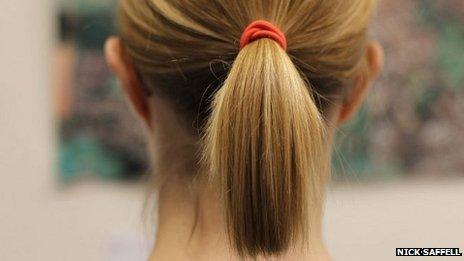Science behind ponytail revealed
- Published

The equation reduces a complex structure to a simple mathematical form
Physicists have come up with an equation that explains and predicts the shape of a ponytail.
The report in Physical Review Letters journal, external could help scientists better understand natural materials, such as wool and fur.
The new equation takes into account the stiffness of hairs, the effects of gravity and the presence of random curliness or waviness.
The work was carried out by a British team of researchers.
"It's a remarkably simple equation," explained Prof Raymond Goldstein, who is the Schlumberger Professor of Complex Physical Systems at Cambridge University.
He added that the findings showed how physics could be used to "solve a problem that has puzzled scientists and artists ever since Leonardo da Vinci remarked on the fluid-like streamlines of hair in his notebooks 500 years ago".
Prof Goldstein worked on the equation with Prof Robin Ball from the University of Warwick and Patrick Warren, from Unilever's Research and Development Centre.
The Ponytail Shape Equation represents the first scientific understanding of the distribution of hairs in a ponytail, say the researchers.
It provides new understanding of how a bundle is swollen by the outward pressure which arises from collisions between the component hairs.
Together with a new mathematical quantity known as the Rapunzel Number, the equation can - they say - be used to predict the shape of any ponytail.
It opens the way to a better understanding of materials made up of random fibres, say the researchers.
This will resonate with some in the computer graphics and animation industry, where a realistic representation of hair and fur has proven a tough challenge.
Prof Goldstein is presenting the research at the American Physical Society meeting in Boston on 28 February.
- Published13 February 2012